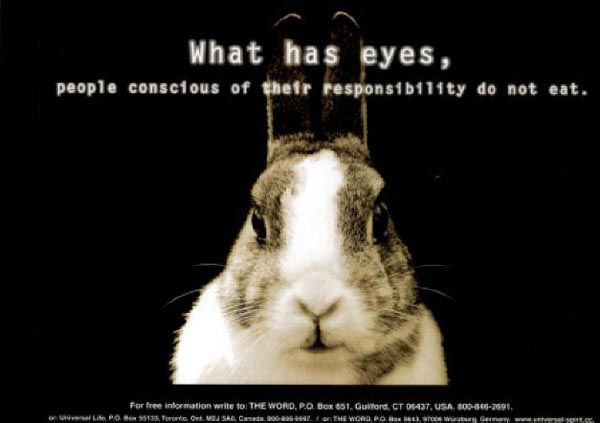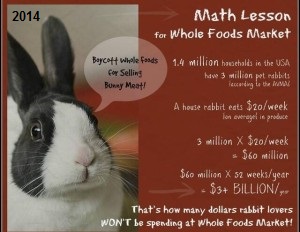Developing the Meat Rabbit Industry
Rabbit touted as healthy cuisine
For years the North American meat
rabbit industry has tried to hype its “product.” In 2004, the United States
proclaimed that it imported more than 1 million pounds of rabbit meat, mostly
from China, nearly doubling from the year before, according to the U.S.
Department of Agriculture. Trendy restaurants were adding it to their menus,
declaring the health benefits, and in 2010 people are being encouraged to raise
and slaughter their own rabbits. Can’t we just leave meat off the table? Are
we that barbaric as to deprive other creatures of their right to enjoyment of
life? 
- A man can live and be healthy without killing animals for food; therefore, if he eats meat, he participates in taking animal life merely for the sake of his appetite. And to act so is immoral. Leo Tolstoy
Russia to develop rabbit industry
March 18, 2010 By Evegen Vorotnikov www.meatinternational.com
The Russian government is planning to develop the domestic rabbit meat industry through the investments on the establishment of rabbit meat farms across the country, while limiting imports from abroad, according to Russian media reports.
The total stock of rabbits in the country currently is more than two million head, which is significantly less compared to the EU numbers, as well as numbers of the Soviet period, when the total stock amounted to 16.3 million head, with annual production of meat more than 200,000 tonness.
Today the share of commercial rabbit meat production in total volume of meat production in Russia is only 0,005%, which is extremely low for such country as Russia. According to experts’ estimates, the domestic rabbit meat production in Russia currently satisfies no more than 5% - 10 percent of the local demand, while the rest is met by imports.
- China remains an absolute leader in terms of rabbit meat supplies to Russia, which accounts for up to 90 per cent of imports. The second place is occupied by Hungary.
- France, Italy, Spain are the largest European producers of rabbit meat, which supply most of its production within the EU.
- Rabbits as repast gains ground in B.C.
- Friend or food?
Wednesday, April 7, 2010 Wendy Stueck, The Globe and Mail
At the University of Victoria, rabbits are cute, plentiful and controversial: Talk of culling makes people squeamish and the university recently spent $18,000 on an unsuccessful program to sterilize and relocate some of the animals. In other parts of the province, however, there are plans afoot to bring bunnies to the table – on a plate. The owner of a mobile slaughterhouse unit based in Cranbrook says he has had several requests to make his facility – up to now used solely for poultry – available for rabbits.
“I gave one customer the okay, because she has the clientele,” said Gerald Brinders, who launched the Kootenay Mobile Poultry Abattoir last year and is working on a second unit to serve a growing number of customers and reduce travel time over steep mountain roads. “People might be raising rabbits for themselves or for their family, and this would allow them to sell an inspected product to consumers.”
One would-be producer is Kyersten Kerr, who runs a hobby farm near Creston and grew up raising bunnies as pets. She’s considered raising rabbits as food for years, but when she approached local slaughterhouses, they said they weren’t interested in handling small numbers of rabbits in their highly regulated facilities. Under provincial legislation introduced in 2004, all meat for human consumption in B.C. must come from a provincially or federally licensed slaughter facility. Slaughterhouse owners spent hundreds of thousands of dollars to upgrade plants, and some small operators closed their doors.
As part of the transition, governments helped pay for mobile slaughterhouses that would cater to smaller producers who would otherwise have to ship their animals hundreds of kilometres to a licensed plant. The first mobile plant began operating in B.C.’s Peace River district in 2007 and processes beef, buffalo and lamb.
Mr. Brinders started building his $125,000 plant – a converted motor home – two years ago and was licensed last year, when, during peak periods, he processed as many as 500 chickens a day. Now, he wants to serve rabbit producers in the region as well. “He was the first abattoir locally even willing to talk about it,” said Ms. Kerr, who’s planning to buy a couple of breeding animals once she has finalized arrangements with Mr. Brinders. The rabbit processing requires a green light from the Canadian Food Inspection Agency, which already oversees Mr. Brinders’s poultry operations.
 There would be strong demand for
B.C.-raised rabbit, says Hills Foods Ltd. owner Mark Hills, who sells specialty
and organic meats, including musk ox and alligator. “Chefs are demanding local,
regional protein, whatever it might be,” said Mr. Hills, who imports rabbit meat
from Quebec.
There would be strong demand for
B.C.-raised rabbit, says Hills Foods Ltd. owner Mark Hills, who sells specialty
and organic meats, including musk ox and alligator. “Chefs are demanding local,
regional protein, whatever it might be,” said Mr. Hills, who imports rabbit meat
from Quebec.
Rabbit is lean, flavourful, can be prepared in a host of different ways, and can be raised with much less food, water and space than pigs or cows, he added. “If this guy came up with some local rabbit,” Mr. Hills said, “I’d buy everything he could get his hands on, provided he could compete with Quebec on price.”
CarminaG 4/8/2010 8:34:00 PM How about a little respect and consideration for the non-human species? We don't need to consume other creatures. Just let them be. I seriously doubt we'd condone cannibalism. Or would we? Rabbits are not cuisine!
Comment: Besides the obvious ethical reasons for not consuming rabbit, or any other creature for that matter, rabbits do not have much usable meat. It has plenty of bones and is not all that nutritious, lacking some vitamins and minerals that are used in the digestive process. It is NOT inexpensive, as the proponents of the industry would have you believe. Reject the suffering and slaughter of innocent beings by enjoying a compassionate lifestyle free of animals and their products.
September 27, 2010 Investors' funds down the rabbit hole; Australian Rabbit Abattoirs Close; No Future says Processor
September 2011 New board for Ontario rabbit producers
August 8, 2013 Feeding rabbits to poor a mindless proposal, Carmina Gooch's letter in the Vancouver Sun
December 18, 2014 Is rabbit the new white meat?
Prevention, a magazine that claims to be about optimizing a healthy lifestyle, has shocked many people this month by actually posing the question: “Is rabbit the new white meat?” Never mind that there has been considerable scientific evidence that proves consuming animals and their products in detrimental to human health. A simpler, ethical way of living is to adopt a plant-based diet.
From Leonardo da Vinci, 1452 - 1519: “I have from an early age abjured the use of meat, and the time will come when men such as I will look upon the murder of animals as they now look upon the murder of men.”
November 15, 2017 Delta Optimist Re: Banquet raises big bucks for Earthwise programs. Ms. Gooch, from the Rabbit Advocacy Group, wrote the Earthwise Society on the 17th, as the menu for this ‘gourmet’ feast was thoughtless and ill-considered. Pan-seared sturgeon with black caviar and stuffed rabbit saddle were among the items offered.
Meanwhile, white sturgeon are fighting for survival in our BC waters and caviar is simply stolen fish eggs, high in cholesterol. Rabbits are companion animals to many people, so why put such a controversial and offensive offering on the menu? Certainly dog meat would never be considered.
The photo to the article depicted a group of attendees who appeared pompous and elitist, and lacking in regard for other species. Suggestions on reading material were given. Hopefully, this won’t be repeated of this next year. A quick response from Cait Murphy, Communications Coordinator, read, in part:
This dinner is a once-a-year event, and we source our meat as sustainably as we can. The white sturgeon and black caviar was sourced from Northern Divine. Rabbits can eat forage rather than grains, cutting down the amount of land that is growing food for livestock; they also require less space than major industry livestock such as cows or pigs; and, they produce less waste. For these reasons they are a very sustainable meat source compared to pigs and cows.
Carmina Gooch wrote to the editors of Prevention as did Patricia Tallman.October 1, 2014 Ontario Rabbit Leaves Livestock Alliance Partnership
Rabbit Farming – The Canadian Encyclopedia (2012) The Canadian Encyclopedia: Rabbit Farming